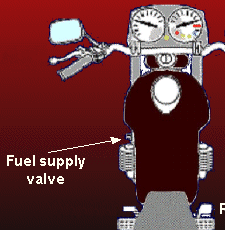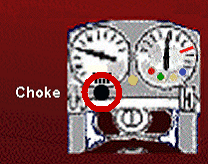Overview 5: Miscellaneous controls
Don’t worry, there are only a few items left — like the fuel supply valve.

The fuel supply valve controls fuel flow from the fuel tank to the engine (on motorcycles that have one — more and more bikes are doing away with this valve as the industry moves to fuel injected engines). If your bike has this valve, it will have three positions — ON / Off/ and RESERVE.
- ON – fuel is supplied to the engine. This is the normal operating position for the valve.
- OFF – fuel is stopped at the valve so none is relived to the engine. This position is usually used if storing the bike for a long period of time.
- RESERVE – selected when you feel the bike hesitate or miss slightly while riding with a constant throttle (and your mileage — nice to have that trip meter set — says you may be running out of gas. RESERVE is sufficient fuel to easily get you to a gas station where the first thing you want to do is reset the valve to ON… because if left in RESERVE by mistake, the next time the bike sputters and hesitates it will be completely out of gas.. and there will be more walking than riding in your future!
The fuel supply valve will ALWAYS be located under/near the fuel tank on left side of the motorcycle so a rider can easily go from ON to RESERVE without releasing the throttle.
If you bike doesn’t have a fuel supply valve, you will have a fuel low indicator light to let you know it is time to look for a gas station in your riding future.

How much fuel is left in your tank when the light illuminates or you go to RESERVE on the fuel supply valve? Don’t ask me, read MOM!
Just two more miscellaneous controls, the choke and ignition (key).

I have indicated the choke‘s location with the red circle, but it can be located in any number of different places on different motorcycles — check with MOM to see its location… and to see if you even have one! With more and more bikes going to fuel injection, this is another manual control manufacturers are doing away with it.
If you have a manual choke you want to use it to warm up a cold engine. It will make your engine idle faster to help it warm up. When you think your engine is warm, turn the choke off and test the engine. You know the engine is warm when it responds immediately to throttle inputs with the choke off. If the engine hesitates when the throttle is turned aggressively, it is trying to tell you it is still cold, so add some choke and wait a minute, then turn choke off and try the throttle response again. If engine responds quickly and smoothly, you are good to go.
Always make sure the choke is off BEFORE you leave your driveway or wherever you were parked. As well as causing the engine to idle abnormally high like when stopped at a stop sign or light, engine damage can occur if operating with the choke on at regular road speeds. So make sure the choke is off before you ride off.
The final item is the ignition, or where you insert you key to turn on your bike. The picture below shows it circled in red, but like the choke, the ignition can be located in any number of places on a bike.

Unlike your car, the key does not start the motorcycle. In the ON position It turns on the motorcycle’s electronics and prepares the bike for starting. To actually start the bike you must ____? (are you thinking press the start button? good on you!). By making the start button start the bike instead of the key, you have both hands on the handgrips during start (pretty ingenious those engineers who incorporate safety so insidiously!).
That’s all there is it! You have looked at all the controls normally found a motorcycle!
Use Next button here or on menu.
